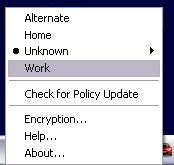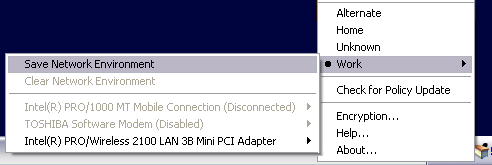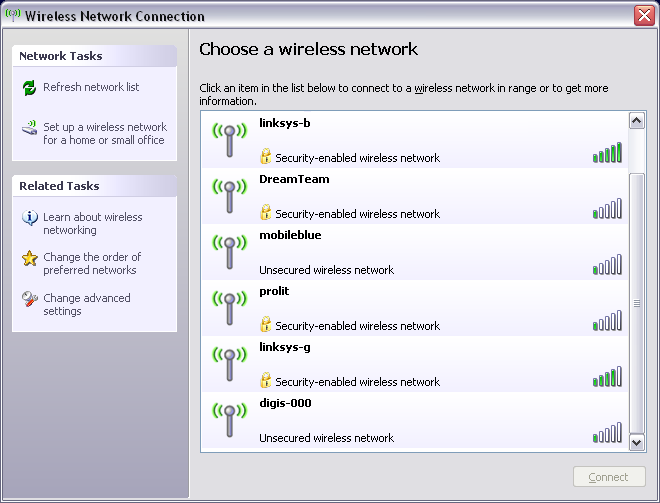3.2 Changing Locations
At startup, the Endpoint Security Client 3.5 switches to the Unknown location. It then attempts to detect the current network environment and to change the location automatically. If the network environment is either unrecognized, or has not been preset or saved (see Section 3.2.1, Saving a Network Environment), the location must be changed manually.
If you cannot perform the following steps, your ZENworks Endpoint Security administrator might have prevented you from changing locations manually.
To change a location:
-
Right-click the icon in the taskbar to display a menu of choices.

-
Click the appropriate location.
3.2.1 Saving a Network Environment
A network environment needs to either be preset in the security policy or saved by the end user before the Endpoint Security Client 3.5 can automatically change locations. Saving a network environment saves the network parameters for the current location, and allows the Endpoint Security Client 3.5 to automatically switch to that location the next time the user enters the network environment. When applied in a Wi-Fi network environment, the Endpoint Security Client 3.5 will LockOn™ to the single selected access point.
To save an environment:
-
Right-click the icon in the taskbar to display the menu.
-
Click the location you want to change to.
-
Right-click the icon, mouse over the current location to display the submenu, then click Save Network Environment to save the environment.

If this network environment was saved at a previous location, the Endpoint Security Client 3.5 asks if the user wants to save the new location. Select to save the environment to the current location and clear the environment from its prior location, or select to leave the environment in the prior location.
NOTE:The function can be restricted by the ESM Administrator at any location.
Additional network environments can be further saved to a location. For example, if a location defined as Airport is part of the current policy, each airport visited by the mobile user can be saved as a network environment for this location. This way, every time a mobile user returns to a saved airport environment, the Endpoint Security Client 3.5 automatically switches to the Airport location.
3.2.2 Saving a Wi-Fi Environment
When users activate their Wi-Fi adapters, they might see dozens of available access points. A Wi-Fi adapter might lock on to a single access point at first, but if too many access points are within proximity of the adapter, the associated access point might be dropped and the wireless connection manager could prompt the adapter to switch to the access point with the strongest signal. When this occurs, current network activity is halted, often forcing a user to resend certain packets and reconnect the VPN to the corporate network.
If an access point is saved as a network environment parameter at a location, the adapter locks on to that access point and does not lose connectivity until the user physically moves away from the access point. Upon returning to the access point, the adapter automatically associates with the access point, the location changes, and all other access points are no longer visible through wireless connection management software.
To save a Wi-Fi Environment:
-
Open the connection management software and select the desired access point.
NOTE:Connection management software can be overridden by location when the ESM security policy is set to manage your wireless connectivity.

-
Specify any necessary security information (WEP or other security key), then click .
-
Complete the steps outlined in Section 3.2.1, Saving a Network Environment to save this environment.
3.2.3 Removing a Saved Environment
To remove a saved network environment from a location:
-
Right-click the icon in the taskbar to display the menu.
-
Change to the appropriate location.
-
Right-click the icon, then select the current location to display the submenu.
-
Click to clear the environment.
NOTE:This clears all saved network environments for this location.